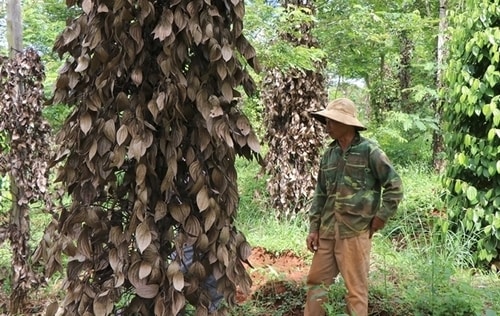Before the pepper price began to fall last year, trucks often rumbled into towns in the Central Highlands province of Gia Lai delivering batches of concrete pillars to pepper farmers.

Farmers in Chư Pứh and Chư Sê Districts, two key pepper-growing areas, had paid VNĐ300 million for dozens of pillars that covered one hectare. But, today, farmers are selling the same number of pillars for VNĐ60-70 million, as many of them have gone bankrupt. Mai Liệu, of Ia Blứ Commune in Chư Pứh District, said that pepper had once made some farmers “millionaires”, but now the same farmers are in serious debt.
They have had to sell their houses and land, and have even left their hometowns to work in other provinces. “Smaller pepper farming households have fallen into even more miserable situations, including displacement from their homes,” Liệu said. Commune chairman Phan Văn Linh said that farmers borrowed bank loans to grow pepper when prices soared, but then stopped growing the plant when prices began to drop.
The farmers were unable to pay back bank loans even after seeking “black credit”, Linh said. According to figures from Gia Lai’s agricultural sector, the province’s black-pepper growing area expanded to 16,000ha last year, though only 6,000ha of pepper were officially planned to 2020. From 2012 to 2016, when the price of black pepper peaked at VNĐ220,000 (US$9.6) per kilo, locals rushed to grow the plant.
However, by the end of 2016, the price of pepper had plummeted to VNĐ55,000-65,000 per kilo. A pepper disease outbreak at the time also caused low yields and a massive death of plants. Pepper growers were then left with deep debt. According to the province’s People’s Committee, by April 2019, pepper growers in the province owned banks about VNĐ4.3 trillion ($184 million), including bad debts of VNĐ2.2 trillion. Pepper growers in Đắk Lắk Province, another key pepper-producing area in Việt Nam, are also in a similar situation.
Nguyễn Khắc Hiển, vice head of the province’s Cultivation and Plant Protection Department, said that authorities planned to use 16,000 ha for pepper farming to 2020, but the pepper growing area in the province had already reached over 42,000 ha by 2017. “The planning was not followed because authorities designed it without developing sanctions to ensure that it would be followed properly,” Hiển said. Farming households play a major role in Central Highlands agriculture, but they have also contributed to the boom and bust atmosphere, according to the Voice of Việt Nam.
The households were vulnerable to market fluctuation, the national radio station said. As certain crops’ prices rose, they rushed to grow them, but then abandoned them when prices fell. Planning issues In other cases, when farmers agreed to follow the authorities’ planning, they were unable to reap the benefits. Between 2008 and 2012, the Ministry of Agriculture and Rural Development assisted Gia Lai, Đắk Lắk, Đắk Nông and Lâm Đồng provinces to shift from 100,000 ha of forestland to rubber growing areas.
As a result, tens of thousands of hectares of rubber trees either died or had very low productivity. Kpă Thuyên, vice chairman of Gia Lai Province People’s Committee, said that about 12,000 ha of rubber trees in the province were in poor condition, and it would be costly to replace the trees with other crops, even though they take up needed farmland.
To replace a hectare of rubber trees, investors would have to re-plant a hectare of forest or pay about VNĐ64 million to the Forest Protection and Development Fund, according to Thuyên. Huỳnh Văn Thòn, chairman of the management board and general director of Lộc Trời Group, an agricultural product manufacturer and service supplier, said that only growers, including farming households and enterprises, could break the vicious circle of “rush to grow, rush to cut down”. He said that enterprises could link production with consumption and help farmers find markets for their products.
To ensure sustainable development, all stakeholders should learn lessons from the last two decades of over development, he said. “Doing business for short-term profit can cause long-term consequences,” Thòn said, adding that farmers, enterprises and scientists should work together and the Government should play the role of rule maker and arbitrator. — VNS



